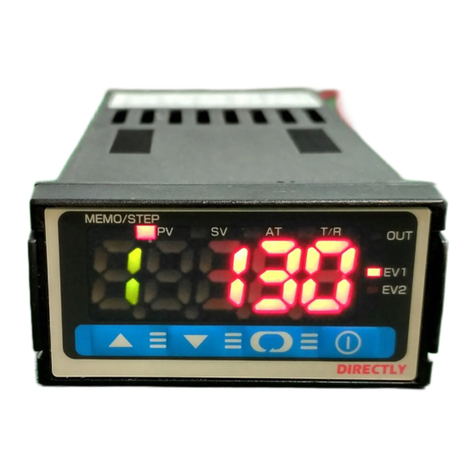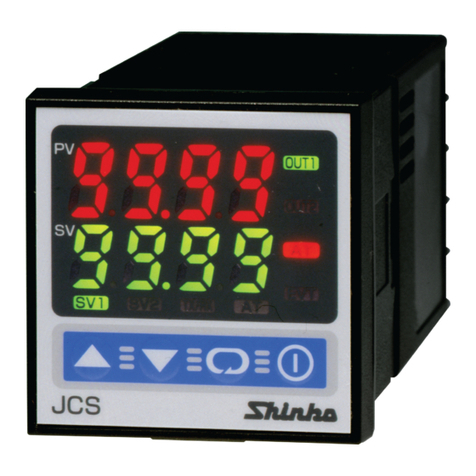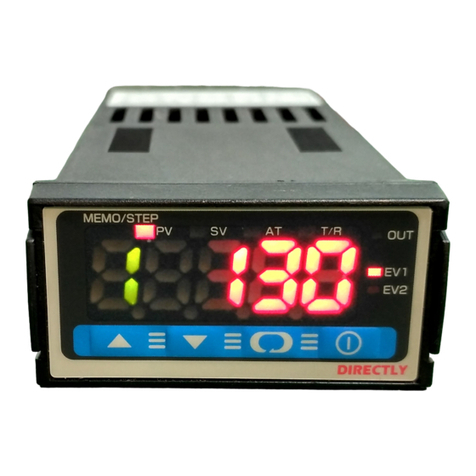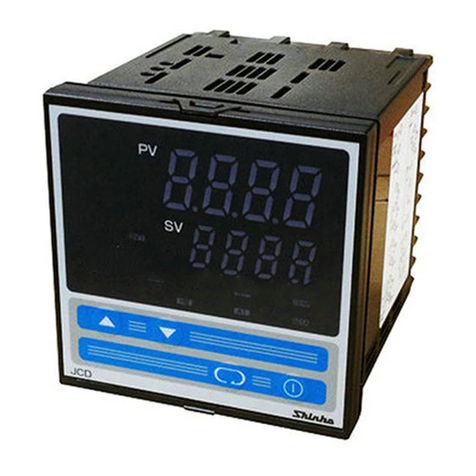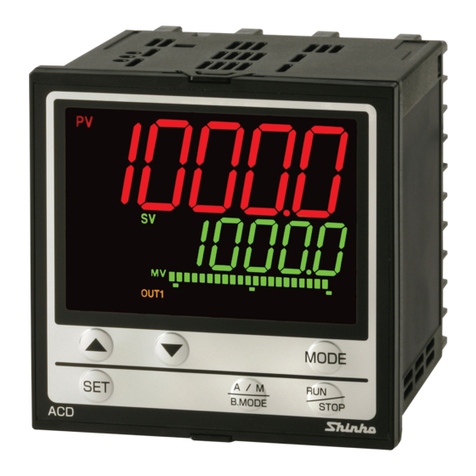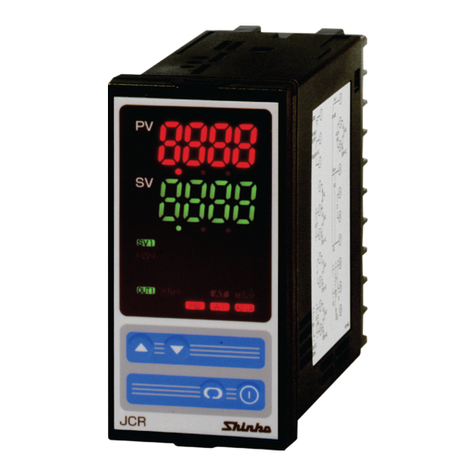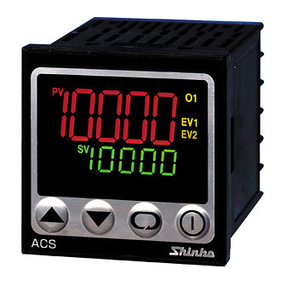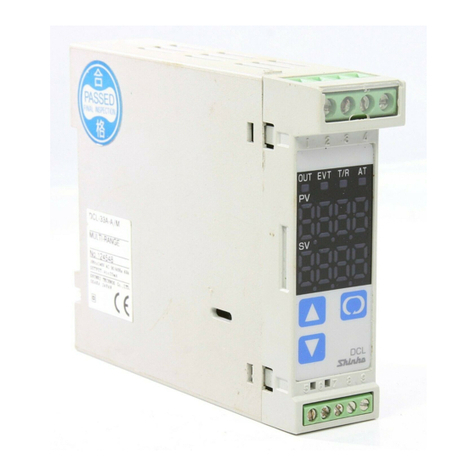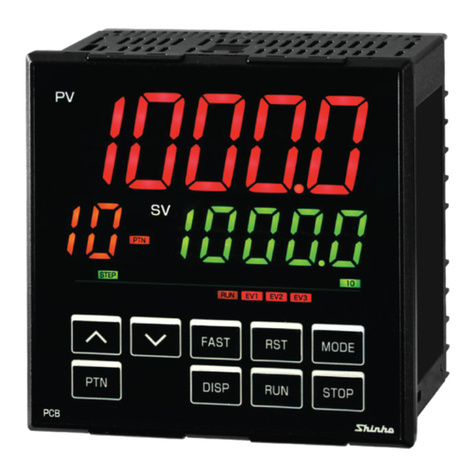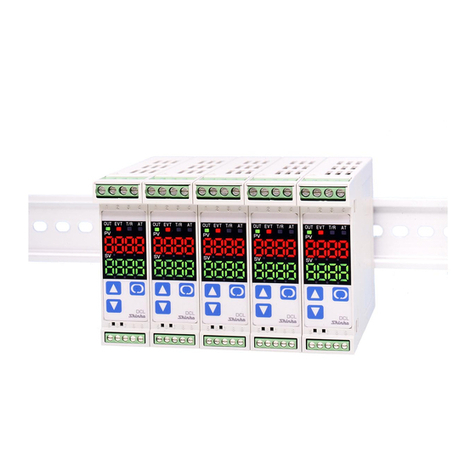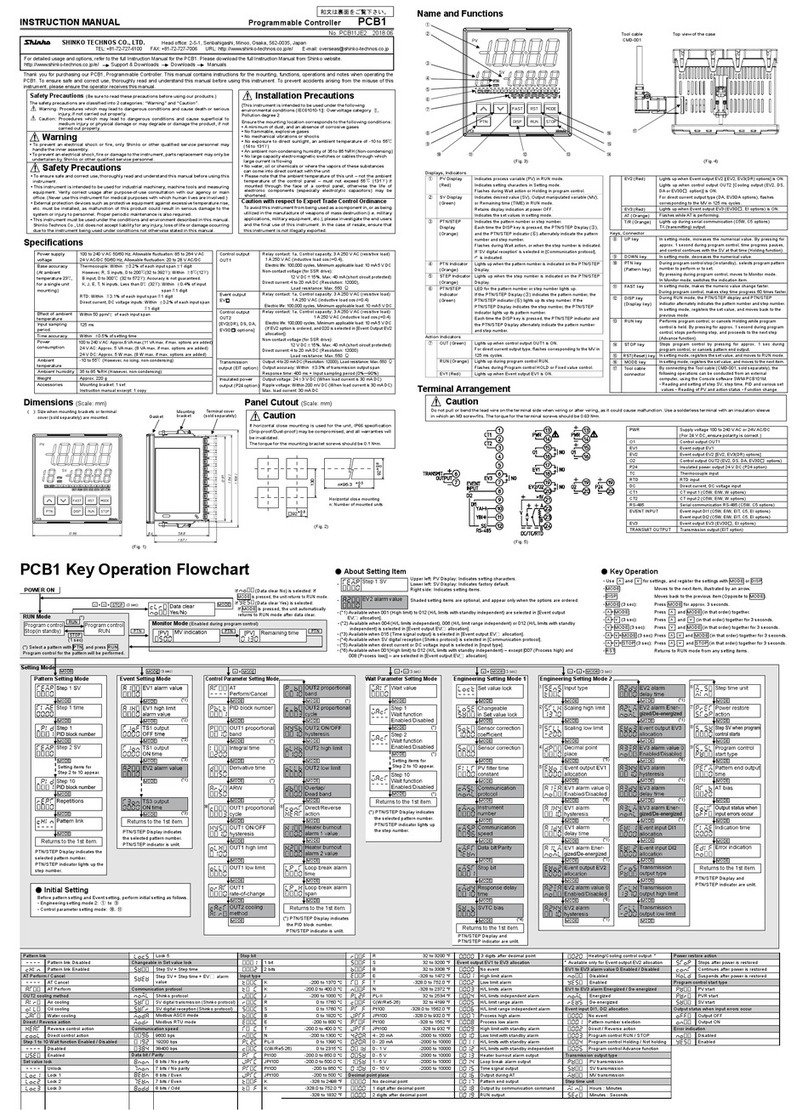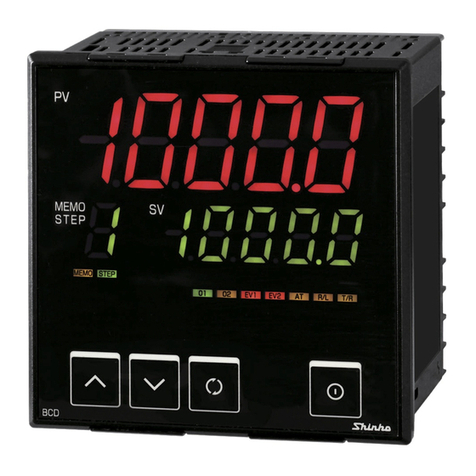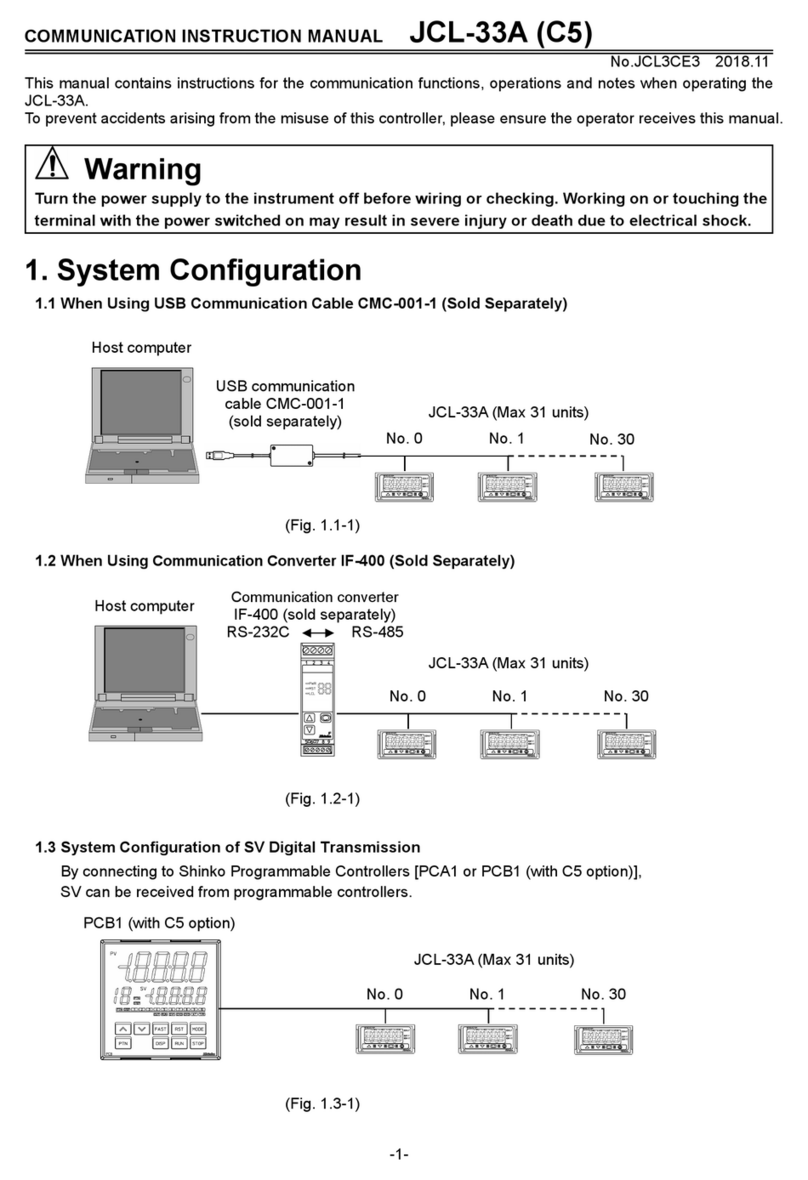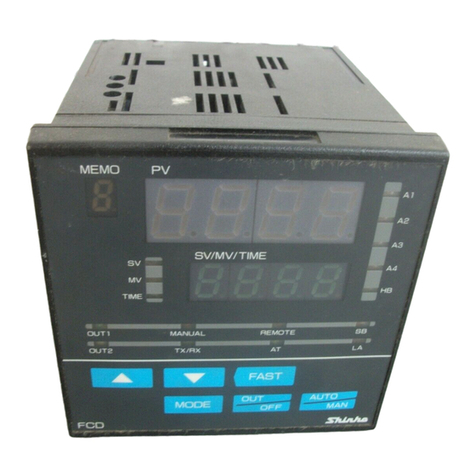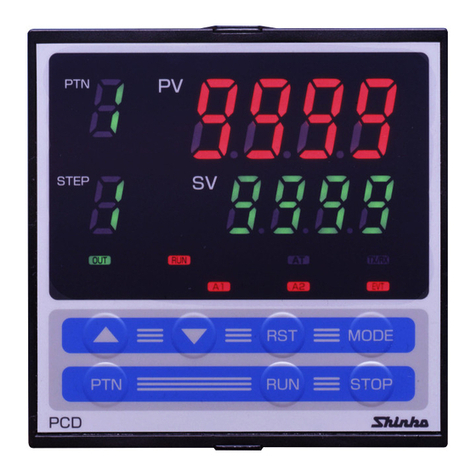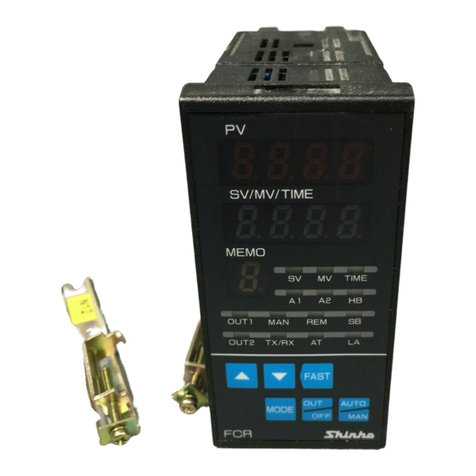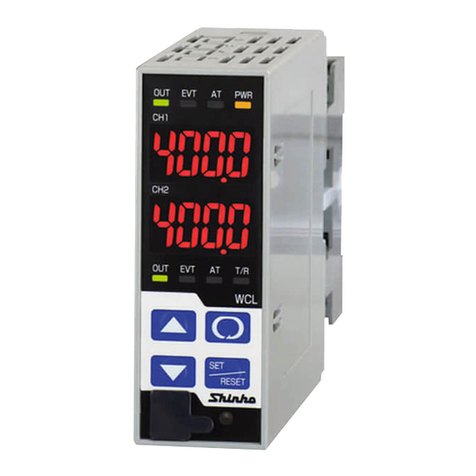Set value lock
Sensor correction
Communication
protocol
Instrument number
Communication
speed
Parity
Stop bit
SV1
(Desired value)
[Main setting mode]
Reverts to the PV/SV Display.
PV/SV Display
PV/SV Display
(8)
(7)
(For 3 sec.)
(For 3 sec.)
[Sub setting mode]
[Auxiliary function setting mode 1]
Reverts to the PV/SV Display.
Reverts to the PV/SV Display.
Reverts to the PV/SV Display. Reverts to the PV/SV Display.
PV/SV Display
Output MV (manipulated
variable) indication
+
PV/SV Display
+
(For 3 sec.)
[Auxiliary function setting mode 2]
PV/SV Display
+
AT Perform/Cancel
OUT1 proportional
band
OUT2 proportional
band
Integral time
Derivative time
ARW
OUT1
proportional cycle
OUT2
proportional cycle
Manual reset
Alarm 1 value
Heater burnout
alarm value
Loop break
alarm time
Loop break
alarm span
Input type
Alarm 1 type
Alarm 1 Energized/
De-energized
Alarm 1
HOLD function
Alarm 1 hysteresis
Alarm 1 delay time
Direct/Reverse
action
AT bias
SVTC bias
Output status when
input errors occur
Controller/Converter
Scaling high limit
Scaling low limit
Decimal point place
PV filter time
constant
OUT1 high limit
OUT1 low limit
OUT1 ON/OFF
hysteresis
OUT2 cooling
method
OUT2 high limit
OUT2 low limit
Overlap/Dead band
OUT2 ON/OFF
hysteresis
(For 3 sec.)
[Auxiliary function setting mode 3]
PV/SV Display
+
Event input
DI allocation
Alarm 3 value 0
Enabled/Disabled
Alarm 3 value
Alarm 3 high limit
alarm value
Alarm 3 Energized/
De-energized
Alarm 3
HOLD function
Alarm 3 hysteresis
Alarm 3 delay time
Alarm 4 type
Alarm 4 value 0
Enabled/Disabled
Alarm 4 value
Alarm 4 high limit
alarm value
Alarm 4 hysteresis
Alarm 4 delay time
Remote/Local
Remote bias
External setting
input high limit
External setting
input low limit
SV Rise/Fall rate
start type
SV rise rate
SV fall rate
Control output
OUT1/EVT
Heater burnout alarm
output Enabled/Disabled
Loop break alarm output
Enabled/Disabled
Alarm 2 output
Enabled/Disabled
Alarm 3 output
Enabled/Disabled
Alarm 4 output
Enabled/Disabled
OUT1 MV preset
value
OUT2 MV preset
value
SUB-MODE key
function
Auto/Manual control
after power ON
SV2
Alarm 1 value 0
Enabled/Disabled
Alarm 1 high limit
alarm value
Alarm 2 type
Alarm 2 value 0
Enabled/Disabled
Alarm 2 value
Alarm 2 high limit
alarm value
Alarm 2 Energized/
De-energized
Alarm 2
HOLD function
Alarm 2 hysteresis
Alarm 2 delay time
Alarm 3 type
Reverts to the PV/SV Display.
(1)
(2)
(3)
(4)
(5)
(6)
Alarm 1 output
Enabled/Disabled
Alarm 4 Energized/
De-energized
Alarm 4
HOLD function
INSTRUCTION MANUAL
DIN Rail Mounted Indicating Controller
DCL-33A
No. DCL31JE2 2017.11
SHINKO TECHNOS CO., LTD.
Head office: 2-5-1, Senbahigashi, Minoo, Osaka, 562-0035, Japan
TEL: +81-72-727-6100 FAX: +81-72-727-7006 URL: http://www.shinko-technos.co.jp/e/ E-mail: overseas@shinko-technos.co.jp
For detailed usage, refer to the Instruction Manual for the DCL-33A. Please download the full Instruction Manual from Shinko website.
http://shinko-technos.co.jp/e/ Support & Downloads Downloads Manuals
Thank you for purchasing our DCL-33A, DIN Rail Mounted Indicating Controller. This manual contains instructions for the mounting, functions, operations and notes when
operating the DCL-33A. To ensure safe and correct use, thoroughly read and understand this manual before using this instrument. To prevent accidents arising from the
misuse of this instrument, please ensure the operator receives this manual.
Safety Precautions
(Be sure to read these precautions before using our products.)
The safety precautions are classified into 2 categories: “Warning” and “Caution”.
Warning: Procedures which may lead to dangerous conditions and cause death or serious injury, if not
carried out properly.
Caution: Procedures which may lead to dangerous conditions and cause superficial to medium injury or
physical damage or may degrade or damage the product, if not carried out properly.
Caution for Installation
This instrument is intended to be used under the following environmental
conditions (IEC61010-1)]: Overvoltage category , Pollution degree 2
Ensure the mounting location corresponds to the following conditions:
• A minimum of dust, and an absence of corrosive gases
• No flammable, explosive gases
•No mechanical vibrations or shocks
• No exposure to direct sunlight, an ambient temperature of 0 to 50 (32 to
122 ) that does not change rapidly, and no icing.
• An ambient non-condensing humidity of 35 to 85 %RH
• No large capacity electromagnetic switches or cables through which large
current is flowing
• No water, oil or chemicals or where the vapors of these substances can
come into direct contact with the unit
• Take note that the ambient temperature of this unit – not the ambient
temperature of the control panel – must not exceed 50 (122 ) if mounted
within a control panel, otherwise the life of electronic components (especially
electrolytic capacitors) may be shortened.
Warning
• To prevent electric shock or fire, only Shinko or other qualified service personnel may handle the inner
assembly.
•To prevent electric shock, fire or damage to the instrument, parts replacement may only be undertaken by
Shinko or other qualified service personnel.
SAFETY PRECAUTIONS
• To ensure safe and correct use, thoroughly read and understand this manual before using this instrument.
• This instrument is intended to be used for industrial machinery, machine tools and measuring equipment.
Verify correct usage after purpose-of-use consultation with our agency or main office. (Never use this
instrument for medical purposes with which human lives are involved.)
•External protection devices such as protective equipment against excessive temperature rise, etc. must be
installed, as malfunction of this product could result in serious damage to the system or injury to personnel.
Proper periodic maintenance is also required.
• This instrument must be used under the conditions and environment described in this manual. Shinko
Technos Co., Ltd. does not accept liability for any injury, loss of life or damage occurring due to the
instrument being used under conditions not otherwise stated in this manual.
Caution with respect to Export Trade Control Ordinance
To avoid this instrument from being used as a component in, or as being
utilized in the manufacture of weapons of mass destruction (i.e. military
applications, military equipment, etc.), please investigate the end users and
the final use of this instrument. In the case of resale, ensure that this
instrument is not illegally exported.
Specifications
Power supply
voltage
100 to 240 V AC 50/60 Hz, Allowable voltage fluctuation: 85 to 264 V AC
24 V AC/DC 50/60 Hz, Allowable voltage fluctuation: 20 to 28 V AC/DC
EVT output
Alarm output:
(Alarm, Loop break alarm and optional Heater burnout alarm utilize common
output terminals.)
The alarm action point is set by deviation from the SV (excluding Process
alarm), and if the input goes outside the range, alarm is turned ON or OFF
(High/ Low limit range alarm).
When De-energized action is selected in [Alarm Energized/De-energized],
alarm is activated conversely.
Setting accuracy: Same as base accuracy
Action: ON/OFF action
Hysteresis: Thermocouple, RTD inputs: 0.1 to 100.0 ( )
DC voltage, current inputs: 1 to 1000 (The placement of the
decimal point follows the selection.)
Output: Open collector, Control capacity: 0.1 A 24 V DC
Alarm type: High limit alarm, Low limit alarm, High/Low limits alarm,
High/Low limits independent alarm, High/Low limit range alarm, High/Low
limit range independent alarm, Process high alarm, Process low alarm,
High limit with standby alarm, Low limit with standby alarm, High/Low
limits with standby alarm, High/Low limits with standby independent
alarm.
Energized/De-energized action are applied to the above alarms, totaling
24 alarm types. No alarm action can also be selected.
Alarm Energized/De-energized: Alarm output Energized/ De-energized can
be selected.
Alarm Energized Alarm De-energized
EVT indicator (Red) Lit Lit
EVT output ON OFF
Alarm HOLD function: Once an alarm is activated, the alarm output is
maintained until the power is turned off.
Loop break alarm output:
(Loop break alarm, Alarm and optional Heater burnout alarm utilize common
output terminals.)
Detects heater burnout, sensor burnout and actuator trouble.
Setting range:
Loop break alarm time: 0 to 200 minutes
Loop break alarm span:
Thermocouple, RTD inputs: 0 to 150 ( ) or 0.0 to 150.0 ( )
DC voltage, current inputs: 0 to 1500 (The placement of the decimal point
follows the selection.)
Output: Open collector, Control capacity: 0.1 A 24 V DC
Base accuracy
(at ambient
temperature 23 ,
for a single unit
mounting)
Thermocouple input: Within 0.2% of each input span 1 digit, or
2(4 ), whichever is greater
However, R, S inputs, 0 to 200 (32 to 392 ): Within 6 (12 )
B input, 0 to 300 (32 to 572 ): Accuracy is not guaranteed.
K, J, E, T, N inputs, Less than 0 (32 ):
Within 0.4% of input span 1 digit, or 4 (8 ),
whichever is greater
RTD input: Within 0.1% of each input span 1 digit or 1 (2 ),
whichever is greater
DC voltage input: Within 0.2% of each input span 1 digit
Direct current input: Within 0.2% of each input span 1 digit
Input sampling
period 125 ms
Power
consumption
100 to 240 V AC: Approx. 5 VA max.
24 V AC: Approx. 4 VA max.
24 V DC: Approx. 4 W max.
Ambient
Temperature,
Humidity
0 to 50 ,
35 to 85 %RH (Non-condensing)
Weight Approx. 100 g
Accessories
Instruction manual excerpt: 1 copy
When W option is ordered: Connector harness 3 m 1 length
When
W option
(5A, 10A, 20A) is ordered: CT (CTL-6-S-H) 1 piece
When
W option
(50A) is ordered: CT (CTL-12-S36-10L1U) 1 piece
When EI option is ordered:
Connector harness AOJ 3 m 1 length
When EA option is ordered:
Connector harness AOJ 3 m 1 length
Control output
(OUT1)
Relay contact: 1a, Control capacity: 3 A 250 V AC (resistive load)
1 A 250 V AC (inductive load cos =0.4)
Electrical life: 100,000 cycles
Non-contact voltage (for SSR drive): 12 V DC 15%
Max 40 mA (short circuit protected)
Direct current: 4 to 20 mA DC,
Load resistance: Max 550
Output accuracy: Within 0.3% of output span
Resolution: 12000
Heating/Cooling
control output
(OUT2)
(DC option)
Output: Open collector, Control capacity: 0.1 A 24 V DC
External Dimensions
(Scale: mm)
Name and Functions
No. Name Description
①
EVTindicator The red LED lights when Event output (Alarm, Loop break alarm or optional Heater burnout alarm) is ON.
The red LED also lights when Cooling output is ON if Heating/Cooling control option is ordered.
②
OUT indicator
The green LED lights when OUT (control output) is ON (when Heating output is ON if Heating/Cooling control option is
ordered).
For Direct current output, flashes in 125 ms cycles corresponding to the output MV.
③
T/R indicator The yellow LED flashes during Serial communication TX output (transmitting).
④
AT indicator The yellow LED flashes while auto-tuning (AT) is performing.
⑤
PV Display Indicates the PV (process variable), or setting characters in setting mode with a red LED.
⑥
SV Display Indicates the SV (desired value), output MV (manipulated variable) or each set value in each setting mode with a green LED.
⑦
UP key Increases the numeric value.
⑧
DOWNkey Decreases the numeric value.
⑨
MODEkey Switches the setting mode or registers the set data.
(Registers the set data by pressing the MODE key.)
⑩
SUB-MODE key
Enters Auxiliary function setting mode 2 in combination with the MODE key.
If ‘Control output OFF’ is selected in [SUB-MODE key function]: Turns all outputs OFF as if the power were turned OFF.
If ‘Auto/Manual control’ is selected in [SUB-MODE key function]: Switches the Auto/Manual control.
If ‘Alarm HOLD cancel’ is selected in [SUB-MODE key function]: Cancels Alarm HOLD.
Caution
When setting the specifications and functions of this unit, connect mains power cable to terminals 1 and 2 first, then set them referring to “Key Operation Flowchart”,
before “Mounting to the Control Panel” and “Wiring”.
Do not pull or bend the lead wire on the terminal side when wiring or after wiring, as it could cause malfunction.
Terminal Arrangement
Name Description
PWR
(POWER SUPPLY)
100 to 240 V AC or 24 V AC/DC
For 24 V DC, ensure polarity is correct.
O1 Control output (OUT1)
TC Thermocouple
RTD Resistance temperature detector
DC
Directcurrent or DC voltage
For Direct current input (when “externally mounted 50 shunt resister” is selected),
connect a 50 shunt resistor between input terminals.
EV Event output
Outputs when Alarm, Loop break alarm or Heater burnout alarm (W option) is ON.
O2 Cooling output (DC option)
RS-485 Serial communication (C5 option)
CT Current transformer input (W option)
EA External setting input (EA option)
EI DI1 input (EI option)
When using ferrules, use the following ferrules made by Phoenix Contact GMBH & CO.
Recommended Ferrules and Crimping Pliers
Terminal
Number
Terminal
Screw
Ferrules with
Insulation Sleeve
Conductor Cross
Sections Tightening Torque Crimping Pliers
1 to 4 M2.6
AI 0.25-8 YE 0.2 to 0.25 mm
2
0.5 to 0.6 N・m
CRIMPFOX ZA 3
CRIMPFOX UD 6
AI 0.34-8 TQ 0.25 to 0.34 mm
2
AI 0.5-8 WH 0.34 to 0.5 mm
2
AI 0.75-8 GY 0.5 to 0.75 mm
2
AI 1.0-8 RD 0.75 to 1.0 mm
2
AI 1.5-8 BK 1.0 to 1.5 mm
2
5 to 9 M2.0
AI 0.25-8 YE 0.2 to 0.25 mm
2
0.22 to 0.25 N・m
AI 0.34-8 TQ 0.25 to 0.34 mm
2
AI 0.5-8 WH 0.34 to 0.5 mm
2
DIN rail
Commu-
nication
C5
(RS-485)
Bottom of the unit
CT
EA
EI
和文は裏面をご覧下さい。
Key Operation Flowchart
●Basic Operation Procedure
Set the input type, Alarm 1 type and SV1 (desired value), following the procedure below.
Setting item numbers (1), (2), (3), (4), (5), (6), (7) and (8) are indicated on the flowchart.
[Step 1]
Operation before RUN
Turn the load circuit power OFF, and turn the power to the
DCL-33A ON.
[Step 2]
Auxiliary function setting
mode 2
Select an input type and Alarm 1 type, etc. in Auxiliary function
setting mode 2.
(1) Select an input type in [Input type].
(2) Select Alarm 1 type in [Alarm 1 type].
If any Alarm 1 type except ( ) is selected, (3) to (6) will
be indicated. Set them if necessary.
Note: If Alarm 1 type is changed, the Alarm 1 value will
default to 0 (0.0). Therefore, set the alarm value again.
(3) Select either Energized or De-energized in [Alarm 1
Energized/De-energized].
(4) Select either Holding or Not holding in [Alarm 1 HOLD
function].
(5) Set Alarm 1 hysteresis in [Alarm 1 hysteresis].
(6) Set Alarm 1 delay time in [Alarm 1 delay time].
[Step 3] Sub setting mode (7) Set Alarm 1 value in [Alarm 1 value].
[Step 4] Main setting mode (8) Set SV1 (desired value) in [SV1 (desired value)].
[Step 5] RUN Turn the load circuit power ON. Control action starts so as to
keep the control target at SV1 (desired value).
●Alarm Type
High limit
alarm
The alarm action is deviation setting from the SV. The
alarm is activated if the input value reaches the high limit
set value.
Low limit alarm
The alarm action is deviation setting from the SV. The
alarm is activated if the input value drops below the low
limit set value.
High/Low limits
alarm
Combines High limit and Low limit alarm actions. When
input value reaches the high limit set value or drops below
the low limit set value, the alarm is activated.
High/Low limit
range alarm
When input value is between the low limit and high limit
set values, the alarm is activated.
Process alarm
Within the scale range of the controller, alarm action points
can be set at random and if the input reaches the randomly
set action
